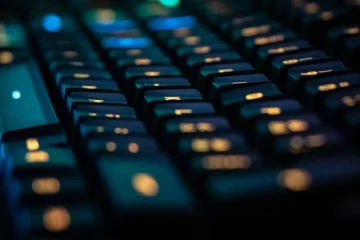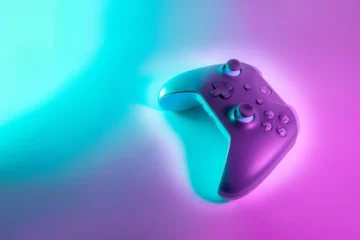First of all, a big DISCLAIMER:
⚠ I am not a doctor: I am just a nerd! If you want or need medical advice, go see your doctor.
I am just a nerd who has been using these primitive input devices (also known as “keyboard” – and later “mouse” and “joystick”) for more than… hmmm… 35 years (!). And I guess I will still be using it for some time, unless some of my predictions for the future become reality.
There was a phase in my life when I seriously thought that I would need to choose another profession, because everything I did in this area needed my hands.
Maybe that was one of the first times I applied the “bio-hacking” concept, even having no idea about this. It was definitely not a popular thing at that time.
It was a scary scenario when I went through it, and MAYBE some of my learning can be useful for someone in a similar situation. But again… I’m not a doctor, etc, etc.
Once upon a long ago…
I started working as a COBOL programmer in 1988. We used those big mainframe terminals with heavy keyboards and green screens. Everything was clumsy, but we kind of survived. Some of the technologies that I have seen since that time were described here.
Before that, I worked as a clerk: most of my working days during 3.5 years were using an adding machine.

Vintage adding machine. Image by TechPhotoGal from Pixabay
I need to admit that in my first years as a programmer I did not know how to handle stress very well, and probably that was part of the problem.
I started feeling pains in my hands and wrists, sometimes letting things fall from my hands (for example, when washing the dishes).
Incident creation
I went to an orthopedist who ordered some ultrasounds and he diagnosed me with tenosynovitis: an inflamation on the tendons and on the synovial membrame, which is the protective sheath around the tendons.
He gave me some anti-inflamatory medication and prescribed me 10 sessions of physiotherapy at his clinic.
At that time, that seemed to be a common problem with people who worked for banks, so some of my colleagues were going thru the same situation.
There was also some interesting phenomenon related with that: some people would exaggerate or even fake the symptoms in order to get away from work.
The situation in itself was stressing, and I was even more distressed when I overheard some “colleagues” questioning if what I had was “real”.
Loops
I continued the treatment (and working in pain) for many months.
I would go to the doctor and he would say:
- How is your pain? “Same”
- OK, continue taking the medication I prescribed (it changed some times) and continue with 10 more physiotherapy sessions at my clinic.
At some point, it dawned on me that this guy didn’t really care much about me.
His clinic was full, people were going back (and getting worse), and he would just give the same advice.
⚠ I am NOT saying that doctors are bad. There are excellent/good/average/bad/awful professionals in any field.
Changes
At that time, my first daughter was born and I would be really scared to let her fall of my arms.
I needed to make some changes.
Someone suggested me to see an acupuncturist, which I didn’t accept immediately. That seemed too “woo woo” to me at the time.
But eventually I went to see one, and that reduced my pain. The acupuncturist also suggested me to do another type of physiotherapy, one that involved gradually increasing movement and reacquiring muscle strength and light stretches (the previous one was mostly passive, with electrical stimulation).
Problem determination
So I had made a decision to change the treatment (I never went back to that first conventional doctor). But I also decided to UNDERSTAND how this tenosynotivitis was acting on me.
I started researching how the mechanical parts of the hands worked.

Image by Pixabay
The principles I got for myself (useful for me and only me, as I am not giving anatomy lessons nor medical advice):
- Muscles are connected to tendons
- Tendons are connected to bones
- When we contract the muscles, that pulls the tendons which in turn move the bones
- Tendons are covered by the synovial membrane, which is filled with a fluid
- In normal conditions, the tendon slides inside the synovia smoothly
- In some conditions (trauma or overuse, for example) the tendons can get inflamed: “tendinitis”
- In other conditions, both the tendon and the synovia get inflamed: “tenosynovitis”
- Muscle work burns energy, and this process releases byproducts (acid lactic, CO2 and others)
- With normal use, the byproducts are taken from the tissues and eliminated from the body. But if there is no rest, they may accumulate there and cause inflamation
- Bad posture can also damage the mechanical parts (so this is why ergonomics are important)
- Pain makes you avoid movement, and that makes it harder for the toxins to be released from the tissues (some movement is needed to help the cleaning process)
- Rest, relaxation and light stretching can alleviate the inflamation
Knowing about the mechanics involved satiated my curiosity and got me to the next point.
Problem resolution
In my case the determining facts for my full recovery were:
- Controlling/reducing the pain. (Fortunately acupuncture was applicable to my case)
- Gradually regaining muscle strength
- Taking rests during the day
- Fixing posture/ergonomics
- Being mindful not to discharge stress/tension on the keyboard through my fingers
I also decided to give something back, after learning those things: I dictated the information to a secretary, and that became a booklet that was then distributed internally at the company. I hope that it was helpful to some people.
The “problem” affected me for many months, but after that I went back to normal in a gradual, slow, steady way.
I could do normal things again, including carrying my daughter, driving, washing dishes, typing. Being able to do “normal” was so good!
I never had a reoccurrence of the problem, and since then I was able to do weight lifting, continued working normally, and even played electric guitar sometimes.
Conclusion
Everything that I wrote here applies only to me, and anyone who has pain or health issues should consult with a specialist.
But the generic approaches that may be useful for others are:
- Get advice from someone you trust
- Try to understand not only the mechanics of the issue, but also how the emotional and mental attitude may be impacting you
- If something is not working, something has to change
- Be open to accept wisdom that you are not familiar with




2 Comments
Stuart Hayez · 2023-06-28 at 13:36
Roberto, continuing your open source mindset, awesome Very intriguing article. The bio hack concept is very cool. Have you looked into the folks who are open sourcing insulin delivery for diabetes?
A big fan.
Ring0
Roberto Nozaki · 2023-06-28 at 22:37
Thanks Stuart! I didn’t know about this open source project that you mentioned… it seems really interesting too, I will check that out! Cheers!
BTW: we also want to read more stuff from you, man 😉